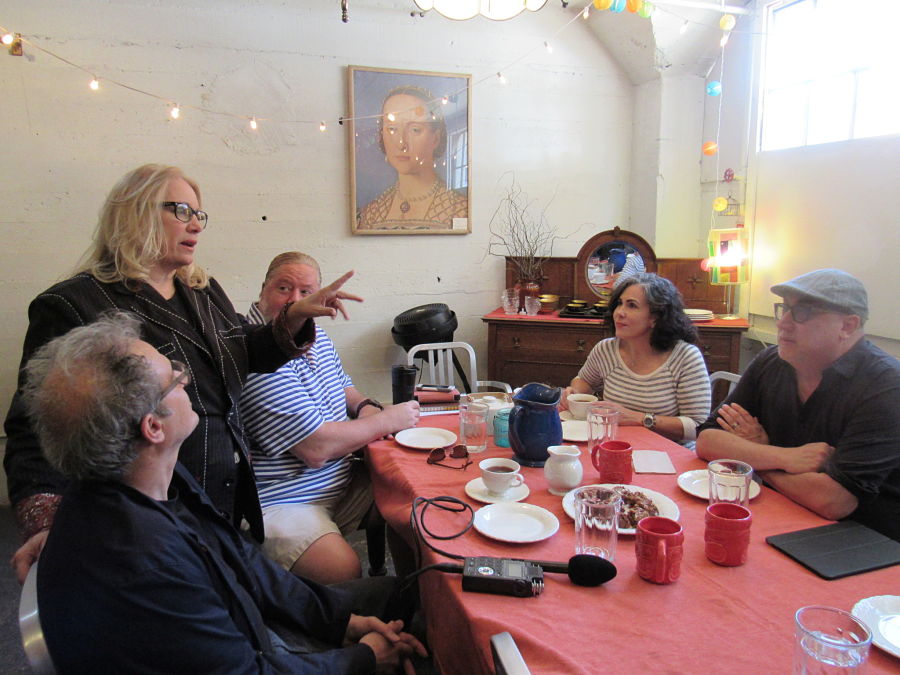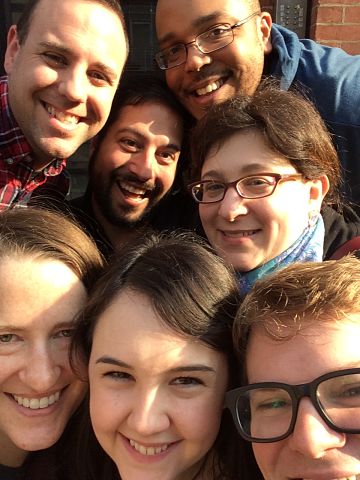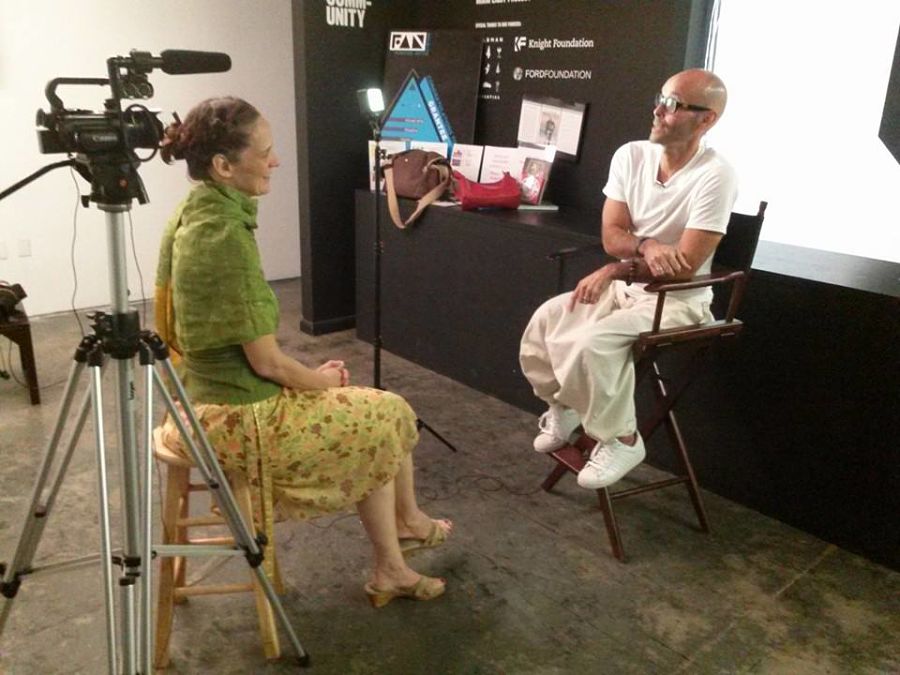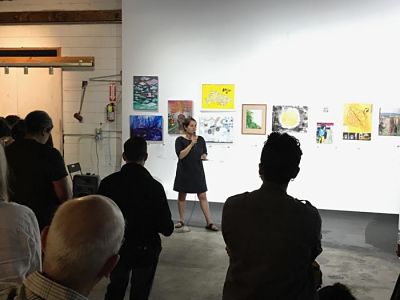In 2011, American Theatre asked me to profile the nation’s 12 most influential theatre critics. After some research and asking around, I settled on a dozen of the most authoritative and diligent full-time reviewers from coast to coast. It was illuminating and inspiring to get to know such a diverse group of colleagues, who had dedicated their lives to the “abstract and brief chronicles” of their local companies.
Today the group portrait I painted is unrecognizable. Of those dozen journalists, half are gone to retirements, buyouts, or termination. Some of the “fallen” six still freelance, but none have the same full-time job with benefits. John Moore of the Denver Post took what he calls a generous buyout. Misha Berson (The Seattle Times), Graydon Royce (Minneapolis’s Star Tribune), Christine Dolen (Miami Herald), and Robert Hurwitt (San Francisco Chronicle) all retired. Only Hurwitt’s post was filled, by Lily Janiak. And in February Charles Isherwood was abruptly fired for undisclosed reasons after more than a decade at The New York Times, to be replaced by Jesse Green.
I’m forgetting someone…who? Oh, right: me. In April I was told that Time Out New York was restructuring and so, after nearly 17 years, we had to part ways. Since then I too have been freelancing and mulling over next steps.
Next steps…What would those be, precisely? Anyone who writes, reads, and cares about theatre criticism knows that jobs and space have been vanishing for years. In a report for the Columbia Journalism Review in January, Jed Gottlieb wrote that “critics at newspapers are dying off even faster than print journalism. Theatre critics, film reviewers, A&E editors, and arts writers of every kind have been stripped from dailies and weeklies around the country.” As the ship of American media plunges into icy waters, the captain cries: Women and children first, and critics over the railing!
More than one person I interviewed for this article reported that in their city or entire state there was not one full-time theatre critic. It’s simple metrics: Reviews don’t get clicks. Who wants to read a stranger’s 1,000-word subjective analysis when you can ask the Facebook hive mind what it thinks? Sure, reviews can be entertaining. A culinary evisceration by Pete Wells may cause a momentary flutter in traffic, but it’s the exception that proves the rule. Publishers and editors are fully aware that criticism is dying. And no one seems to be mourning.
There are survivors amid the carnage. By my informal estimate, about two dozen full-time theatre critics may be employed across the nation, if you include folks who also serve as editors or split their beats with coverage of dance or opera. Whatever the exact figure (and Bill Hirschman, chairman of the American Theatre Critics Association, couldn’t provide one), it’s an exclusive club that stopped inviting new members. And who wouldn’t love to join? A staff theatre critic at New York or The New York Times makes around $80,000 to $150,000 (and up): a cushy paycheck and a big megaphone.
On the next rung are journalists who freelance for one or more mainstream media titles but maintain side hustles to pay the bills. Some reviewers contribute to indie arts sites for $50 or $100 a piece, or sometimes zero—they’re just grateful for the free seats. Other self-starters go into business for themselves. The New York-based aggregator Show-Score includes reviews from the usual suspects: New York’s Daily News, Newsday, NY1… but keep scrolling and the names start sounding unfamiliar. This Week in New York Blog? TheaterScene.net? It’s getting harder to distinguish message-board fan chatter from citizen journos.
Is this caste system the future of theatre criticism? On one side a wading pool of compensated pros, on the other a swarming mass of unedited amateurs with domain names and hot takes? There must be alternatives. Luckily, new models have emerged to pick up the slack left by local media and elevate arts writing above snarky, thumbs-up-or-down consumer reporting. I sketch out a few below, taking into consideration factors like economics, distribution, and funding.
PublishYourself.com
Unless your reviews are posted on heavily trafficked media platforms (and even those are run by bean-counters who look askance at stage-centric content), the vast majority of critics have a hard time simply getting their wares to market. For the independent critic, distribution models are limited: social media feeds, Google searches, perhaps a rave e-blasted by the producers.
 Then there are aggregators. For any given production, Show-Score members (a staggering 200,000) can read everyone from The New York Times to Theatre’s Leiter Side, a blog started by Samuel Leiter. To veteran critics, this leveling of the field might be seen as a further erosion of their authority and expertise. For the consumer, it represents freedom from a mere handful of sources. (It’s not pure democracy at Show-Score; reviewers are ranked according to an “influence” formula based partly on number of reviews and popularity among members.) Show-Score maintains an illusion: To look at the site, you’d think our profession were healthier than ever.
Then there are aggregators. For any given production, Show-Score members (a staggering 200,000) can read everyone from The New York Times to Theatre’s Leiter Side, a blog started by Samuel Leiter. To veteran critics, this leveling of the field might be seen as a further erosion of their authority and expertise. For the consumer, it represents freedom from a mere handful of sources. (It’s not pure democracy at Show-Score; reviewers are ranked according to an “influence” formula based partly on number of reviews and popularity among members.) Show-Score maintains an illusion: To look at the site, you’d think our profession were healthier than ever.
This magic trick has been accomplished by identifying and serving a community that loves to talk about shows and compare notes. While most media companies fish for national traffic using lowest-common-denominator cultural clickbait, Show-Score founder Tom Melcher built it—and the community has come. Show-Score doesn’t just provide a forum for spectators and critics to share their thoughts side by side; it offers discounts, special classes, and social outings for theatre fans. It’s local, it’s niche, it’s geeky, and it’s growing fast. Whether the company (which has $2 million of investor cash behind it) will blow up or go national is anyone’s guess. But it’s a party you’d be a fool not to pop in on.
Outside New York several sites have sprung up in the past decade to fill the void left by vanishing arts desks: Boston’s Arts Fuse, run by longtime critic and scholar Bill Marx; Los Angeles’s punchy Stage Raw; Bill Hirschman’s own FloridaTheaterOnstage.com; and DC Theatre Scene in our nation’s capital. Other locales with indie arts sites include Philadelphia (Broad Street Review), Dallas/Fort Worth (TheaterJones), Oregon (Oregon Arts Watch), and Chicago (Third Coast Review). And New York has Theatre Is Easy, Culturebot, OffOffOnline, and others.
So critics living in these areas theoretically have a distributor. That doesn’t make reviewing for Stage Raw or Arts Fuse, practically speaking, more than a hobby. Of the sites I contacted, only one—DC Theatre Scene—has a paid, full-time employee (editor Lorraine Treanor). The rest are staffed by part-time or volunteer editors and administrators. Freelancers may number 2 to 60, but compensation (where it exists) ranges between $25 and $200 per article. Operating budgets comprise a mix of local advertising, private donations, and the occasional grant.

Traffic numbers vary. Texas’s TheaterJones is one of the busier sites, reporting about 80,000 visitors and up to 310,000 page views a month. “We cover not only the big and established organizations, but emerging and small-budget arts of interest,” says chief theatre critic and editor Mark Lowry. He laments that Fort Worth’s daily papers have turned their backs on a thriving theatre and opera scene. “Right now, we might be the biggest game in town,” Lowry says. “There are some blogs, but TJ has become the voice of the arts here. I’m very proud of that, and although it has been rough to keep doing this for not much pay, we are fiercely devoted to it.”
Podcasts are a cheap, lively alternative for publishing theatre content but, as with indie sites, no one has found a way to make them profitable. Lindsay Barenz created the NYC-based chat series Maxamoo in 2012 because, she says, she wasn’t getting enough advance word about shows through mainstream sources. Today Maxamoo gets about a thousand downloads per podcast, but Barenz has no illusions about it as a business model. “I don’t think that there’s much opportunity to monetize a podcast about theatre beyond Broadway,” she concedes. “We’re operating in a niche within a niche.”

Besides bringing attention to Off and Off-Off Broadway, Barenz wants to create a space for non-white voices to comment on the field. She sees the lack of diversity in theatre criticism as one reason for its growing irrelevance. At the same time, she rejects the idea that theatre critics have it harder than other journalists. “I don’t view theatre criticism as having a special crisis in the media world,” Barenz asserts. “Journalism as a whole is having a crisis. The monetization models are struggling across the board. The fate that’s befallen theatre criticism is a symptom of the larger problem. When we figure out how to operate successful, financially stable media companies, we can apply whatever that solution is to theatre criticism.”
How can media companies become more stable? Shedding print editions may be a start. The cash that publishers save on materials and distribution could be redirected to cultural content: Get rid of paper and ink, hire a theatre critic. Sadly, it’s hard to believe that’s going happen. If a media company divests itself of print and competes entirely in a digital, SEO-driven marketplace (as most already are), the demand for local news, let alone culture coverage, grows even fainter. Content must be national in scope, downloadable, instantly streamed or purchased online. It must attract clicks from a mass audience, and that means pop music, Hollywood movies, celebrities, and trend-mongering.
Still, may a thousand podcasts bloom. TCG produces Offscript, a monthly chat with American Theatre writers and editors, and in September TCG premiered Three on the Aisle, featuring critics Elisabeth Vincentelli, Peter Marks (The Washington Post), and Terry Teachout (The Wall Street Journal). The jury is out on whether those charismatic talkers can drive downloads comparable to their readership at major publications. If there’s a cult-hit theatre podcast out there on the order of WTF with Marc Maron, I haven’t heard it.
Podcasts should be one plank of a digital platform that includes news, reviews, user-generated content, merchandise, and tickets. The parts are out there, but no one has yet properly assembled them.
A Foundation to Grow
All these sites operate independent of each other, with their own editorial policies and strategies for survival. Imagine if a combination of NEA funding, foundation cash, and private donations established a program to link them, standardize the platform, and create a national home for informed, independent arts writing? You’d have a TheaterJones in every major market in the country. We’re talking about something like a ProPublica for arts journalism. ProPublica was started in 2007 by billionaires Herbert and Marion Sandler, who lay out about $10 million per year to support the project. It has been edited by newspaper veterans such as Paul Steiger (The Wall Street Journal) and Stephen Engelberg (The Oregonian). The site describes itself as an independent, nonprofit news source with an emphasis on “investigative journalism with moral force.”
The smartly designed and superbly written 4Columns might be a mini-ProPublica for the arts. Launched in September 2016, the New York-based review site covers books, theatre, art, film, music, and other fields. Every Friday the site publishes four new pieces, “not a ton, but designed that way so that the site can be digestible on a weekly basis,” explains senior editor Brian Parks (formerly of The Village Voice). In the realm of theatre, 4Columns runs about two reviews a month, usually written by Helen Shaw or James Hannaham. Invariably these reviews are probing, elegant 1,000-word essays (for which the writers get paid a respectable $1,000).
The site was created by Margaret Sundell from a bequest in her late mother’s will earmarked for philanthropic endeavors. Sundell explains that she and her parents “shared a commitment to criticism that is complex, accessible, and eloquent.” An annual budget of $400,000 (administered by a private foundation) pays for two full-time employees with health benefits and three part-time employees without benefits. It’s a small but handsome model for brainy, well-curated arts writing. But Sundell is dubious about whether 4Columns will be the wave of the future; its current funding scheme will keep it in operation for maybe 5 to 10 years. “Given the decline of commercial outlets, that may indeed be where the future of arts criticism lies,” she says, “in such interstitial and serendipitous initiatives.”
Still, foundations—big ones with national charters and multi-year plans—could be key to subsidized arts criticism. Last October The Boston Globe announced the appointment of Zoë Madonna as its temporary music critic, a post funded by the Rubin Institute for Music Criticism, San Francisco Conservatory of Music, and Ann and Gordon Getty Foundation. Madonna, a recent graduate of Oberlin College, became the first newspaper arts critic supported by a foundation. Her extended gig at the Globe runs through September 2018. After that, who knows where she’ll go?
“The Globe job has resulted in a few other opportunities and offers,” Madonna reports via email, “though I haven’t been able to take any of them because this keeps me busy enough.”
Arts Writing as Civic Duty
Until foundations or theatre-mad billionaires pony up for our salaries, we could turn to the state. Artburst Miami is a fascinating civic experiment in Florida, a multi-platform arts site funded by the Miami-Dade County Department of Cultural Affairs and administered through the Arts & Business Council of Miami. Anne Tschida, Artburst’s editor-in-chief, explains that local officials responded to the drying up of arts coverage by granting about $60,000 to hire freelance journalists who formerly worked at some of the publications. The site publishes reviews, previews, and special promotional videos. Christine Dolen, formerly of the Miami Herald, is one of Artburst’s main theatre critics (she was profiled in my 2011 AT article).
And here’s a neat twist: Once it has edited and published a piece, Artburst turns around and offers it to local papers to run for free. So Miami-Dade County is effectively subsidizing not only unemployed arts writers but the outlets that may have eliminated their positions.

“As it turns out, the whole reason we exist is that papers are saying, ‘No, we don’t want to pay for this stuff. We don’t get enough clicks,’” Tschida says. “My response is always: That’s not a model you can use for cultural arts coverage. I mean, it’s something that a paper should do, to keep everything running. It’s a circular motion, right? You’ve got companies that say, ‘If I put on a production and nobody covers it, I may never put on another show again.’” In other words, the county is funding a news desk to support small local businesses that happen to be theatres, dance groups, and music ensembles.
Of course, $60,000 a year only goes so far. Tschida and her colleagues work from home on a part-time basis, although the freelance fee of $200 per piece is better than the national average for indie arts sites. There’s hope that foundation money can lift Artburst to the next level. Until other counties and states adopt this model, however, it remains a Sunshine State anomaly.
Embedded and Loving It
There aren’t many success stories in this brave new world of atomized media sites and pro bono reviewing for a hodge-podge of outlets. But Colorado journalist John Moore is something of a pioneer in post-media journalism: He’s an in-house reporter and editor for a large institutional theatre. After a decade as the Denver Post theatre critic, Moore took a buyout. According to him, it wasn’t a career setback; he was chasing the future of his profession.
“One of the reasons I took the buyout was because I’d been approached by a local nonprofit organization about the possibility of starting up a whole new media outlet to cover arts and culture in Denver,” Moore says. “It was going to be this million-dollar grant, and I worked with this foundation for about eight months, and at the last minute, it fell apart. The money went to Colorado Public Radio.”
After a brief “Oh, crap” period, Moore got a call from the marketing department of the Denver Center for the Performing Arts. After meeting with Denver Center CEO Dan Ritchie, Kent Thompson, then artistic director of the theatre company, and Randy Weeks of the Broadway division, Moore received an offer to come and create online content in-house.

And so the DCPA NewsCenter was born. Though he says he was not hired for commercial reasons, once inside the organization Moore realized the economic impact of his journalism.
“After I got here, I was told my decision to leave the Post was actually costing the Denver Center revenue,” Moore recalls. “At the Post, I covered the entire Colorado theatre community. Part of that was thinking of the Denver Center like the Broncos; whatever show they did, I always did a preview and reviewed. You do that over a period of time, and that gets added to their revenue projections.”
Moore has given up reviewing, but he produces a steady stream of previews and stories about the Denver Center’s work, as well as that of other companies around the state. He understands when friends at newspapers ask whether he can remain impartial with the theatre signing his checks, but he claims editorial independence.
“What I’m doing now you could call advocacy journalism, because I’m not out to hurt anybody,” Moore asserts. “Everything I do is about building the buzz about the theatre that’s going on across one of the biggest states in the country with 80-something theatre companies. In the same way I’m not a critic, I’m also not a cheerleader. There’s nothing I’ve written on the NewsCenter that I wouldn’t have written and submitted to my editor at the Post. Because if it doesn’t read like journalism, then I don’t have any credibility.”
Apparently credibility pays. There’s a button at the bottom of each DCPA NewsCenter story that lets the reader click to purchase tickets, and, says Moore, “The numbers are showing that people do respond to content. If you give people credible, compelling information about art, they’re going to want to see it themselves. It will pay for itself. I’m coming up on three years of doing this, and as of now, the analytics credit NewsCenter content with selling $685,000 worth of tickets in three years.” Maybe it’s time to ask for that raise.
Claudia La Rocco does not have to worry about earning her keep at Open Space, the digital journal of the San Francisco Museum of Modern Art. As the site’s editor-in-chief, La Rocco, a former dance and performance critic at The New York Times, has greater intellectual and journalistic freedom than most of her colleagues scuttling across the post-media hellscape. La Rocco says that she has an annual budget of $60,000 to $80,000 to spend on honoraria for critics, academics, and essayists to write about what they want. By its very nature and home in a modern-art museum, Open Space doesn’t keep disciplines in silos or behave like a traditional media property.

“We don’t have genre categories built into the site, because we think there are more interesting and pertinent ways to organize and frame artistic production,” La Rocco says. “And we don’t typically publish reviews. It doesn’t seem appropriate for a platform within a major institution to be passing judgment on artists and other spaces in a thumbs up/thumbs down sort of way.” Last year the site averaged more than 11,000 page views a month. There’s interest in growing those numbers, but no commercial demand to do so. For survivors of mandatory clickbait and moronic SEO gambits, it sounds like heaven.
“The question of how to rebuild arts-writing infrastructure is very much present within institutions right now,” La Rocco says, “and I see a lot of places creating heartening initiatives.” I ask La Rocco if here in New York she could envision such a digital journal housed at Lincoln Center Theater, at the Public Theater, or at BAM.
“Something like Open Space could live in any theatre that values engaged discourse,” she responds. “It’s not rocket science! If there’s money for fancy lobbies, there’s money for criticism, no? The real question is, how do arts institutions see their role in this culture. Why do we exist? What value do we offer?”
What am I worth? What is my opinion worth? Is anybody listening? Questions that every arts journalist asks the mirror in the middle of the night. There’s no single answer, but there are several lively suggestions. The fact that hundreds of writers, editors, artists, and philanthropists across the country are testing new models to pay for good writing and get it to eager readers is a reason to hope. Maybe theatre criticism will become a local, artisanal activity, quaint and cherished by some, but otherwise mostly invisible. Maybe large foundations and state governments will keep it alive as a public good. Hirschman believes it’s the ATCA’s duty to mentor and encourage the next generation of critics, so that they can get the technology/methodology formula right.
“I really believe that we’re all in a dark room feeling our way around and bumping into furniture,” Hirschman muses. “But we keep thinking that there is a light switch.”
Let’s hope someone finds that switch soon and turns it on.
David Cote is a journalist, playwright, and opera librettist. He currently writes for the Village Voice and others.


